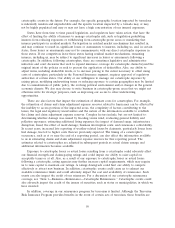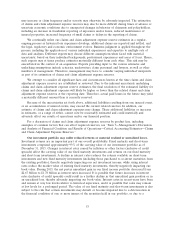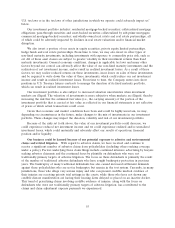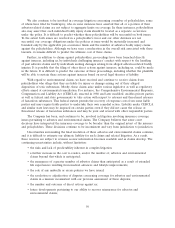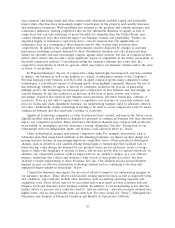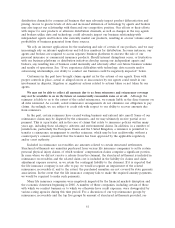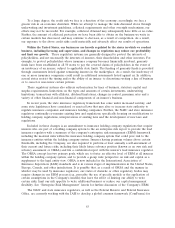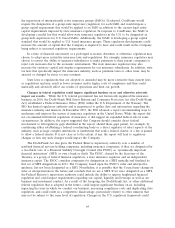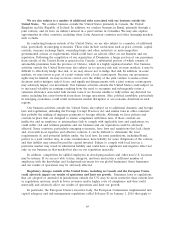Travelers 2015 Annual Report Download - page 59
Download and view the complete annual report
Please find page 59 of the 2015 Travelers annual report below. You can navigate through the pages in the report by either clicking on the pages listed below, or by using the keyword search tool below to find specific information within the annual report.years, pension and hedge funds and other entities with substantial available capital and potentially
lower return objectives have increasingly sought to participate in the property and casualty insurance
and reinsurance businesses. Well-capitalized new entrants to the property and casualty insurance and
reinsurance industries, existing competitors that receive substantial infusions of capital, as well as
competitors that can take advantage of more favorable tax domiciles than the United States, may
conduct business in ways that adversely impact our business volumes and profitability. Further, an
expanded supply of reinsurance capital may lower costs for insurers that rely significantly on
reinsurance and, as a consequence, those insurers may be able to price their products more
competitively. In addition, the competitive environment could be impacted by changes in customer
preferences, including customer demand for direct distribution channels, not only in personal lines
(where we currently and may increasingly compete against direct writers), but also in commercial lines
(where direct writers may become a more significant source of competition in the future, particularly in
the small commercial market). Consolidation within the insurance industry also could alter the
competitive environment in which we operate, which may impact our business volumes and/or the rates
or terms of our products.
In Personal Insurance, the use of comparative rating technologies has impacted, and may continue
to impact, our business as well as the industry as a whole. A substantial amount of the Company’s
Personal Insurance new business is written after an agent compares quotes using comparative rating
technologies, a cost-efficient means of obtaining quotes from multiple companies. Because the use of
this technology, whether by agents or directly by customers, facilitates the process of generating
multiple quotes, the technology has increased price comparison on new business and, increasingly, on
renewal business. It also has resulted in an increase in the level of quote activity and a lower
percentage of quotes that result in new business from customers, and these trends may continue or
accelerate. If we are not able to operate with a competitive cost structure or accurately estimate and
price for claims and claim adjustment expenses, our underwriting margins could be adversely affected
over time. Additionally, similar technology is starting to be used to access comparative rates for small
commercial business and that trend may continue or accelerate.
Significant technology companies or other third parties have created, and may in the future create,
digitally-enabled alternate distribution channels for personal or commercial business that may adversely
impact our competitive position. These alternative distribution channels may compete with us directly
by providing, or arranging to provide, insurance coverage themselves. See also ‘‘Disruptions to our
relationships with our independent agents and brokers could adversely affect us’’ below.
Other technological changes may present competitive risks. For example, innovations, such as
telematics and other usage-based methods of determining premiums, can impact product design and
pricing and may become an increasingly important competitive factor. Other potential technological
changes, such as driverless cars, assisted-driving technologies or technologies that facilitate ride or
home sharing, could disrupt the demand for our products from current customers, create coverage
issues or impact the frequency or severity of losses, and we may not be able to respond effectively. In
addition, our competitive position could be impacted if we are unable to deploy, in a cost effective
manner, technology that collects and analyzes a wide variety of data points (so-called ‘‘big data’’
analysis) to make underwriting or other decisions. See also ‘‘Our business success and profitability
depend, in part, on effective information technology systems and on continuing to develop and
implement improvements in technology’’ below.
Competitive dynamics may impact the success of efforts to improve our underwriting margins on
our insurance products. These efforts could include seeking improved rates, as well as improved terms
and conditions, and could also include other initiatives, such as reducing operating expenses and
acquisition costs. These efforts may not be successful and/or may result in lower retention and new
business levels and therefore lower business volumes. In addition, if our underwriting is not effective,
further efforts to increase rates could also lead to ‘‘adverse selection’’, whereby accounts retained have
higher losses, and are less profitable, than accounts lost. For more detail, see ‘‘Item 7—Management’s
Discussion and Analysis of Financial Condition and Results of Operations—Outlook.’’
59



